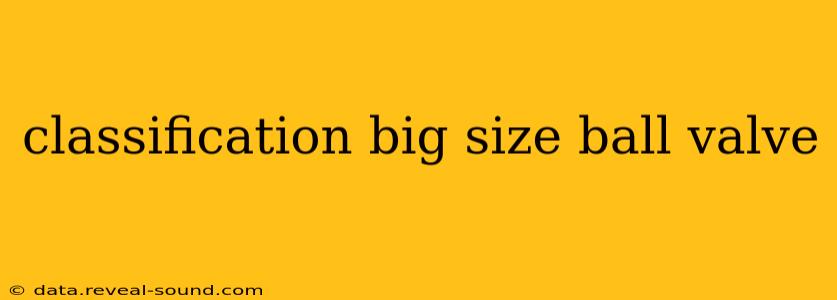Large-size ball valves, typically those with a bore size exceeding 2 inches, play a crucial role in various industries, including oil and gas, water management, and chemical processing. Their classification is multifaceted, encompassing several key characteristics that determine their suitability for specific applications. This guide delves into the various ways these valves are categorized to help you understand their nuances and select the right one for your needs.
How are Large-Size Ball Valves Classified?
Several factors influence the classification of large-size ball valves. These include:
-
Body Material: The material of the valve body dictates its resistance to corrosion, temperature extremes, and pressure. Common materials include cast iron, ductile iron, stainless steel (various grades), and specialized alloys like Monel or Hastelloy for aggressive environments. The choice depends heavily on the fluid being handled and the operating conditions.
-
End Connections: This refers to how the valve connects to the piping system. Common types include flanged, butt-welded, threaded, and wafer connections. Flanged connections are popular for larger valves due to their ease of maintenance and replacement. Butt-welded connections offer superior strength and leak-tightness, often preferred in high-pressure applications.
-
Ball Material: The ball itself can be made from various materials, matching or differing from the body material. Stainless steel is a common choice due to its durability and corrosion resistance. However, other materials may be used depending on the fluid compatibility and operational requirements.
-
Sealing Mechanism: The sealing mechanism ensures a tight shut-off. Common types include PTFE (polytetrafluoroethylene) seats, which offer excellent chemical resistance, and metal-to-metal seats, providing exceptional durability and resistance to high temperatures and pressures. The selection depends on the application's specific demands.
-
Actuation Type: This relates to how the valve is operated. Manual operation (lever or handwheel) is suitable for smaller, less frequent operations. For larger valves or those requiring remote control, pneumatic (air-powered) or electric actuators are often used. The choice depends on the level of automation and accessibility of the valve.
What are the Different Types of Large Ball Valves?
Based on the factors above, large ball valves can be further classified into different types:
-
Trunnion Mounted Ball Valves: These valves use a trunnion to support the ball, resulting in better stability and durability, especially for larger sizes and higher pressures. They're less susceptible to wear and tear than floating ball valves.
-
Floating Ball Valves: In these valves, the ball floats freely within the valve body, relying on the pressure of the fluid to maintain its position. They are generally simpler and less expensive than trunnion-mounted valves but may have limitations in high-pressure applications.
-
Three-Way Ball Valves: These valves allow for three-way flow control (e.g., diverting flow between two lines). This type is frequently used for mixing or diverting fluids.
-
High-Performance Ball Valves: Designed for demanding applications, these valves often incorporate features such as enhanced sealing mechanisms, specialized materials, and fire-safe designs to meet stringent safety standards.
What is the Difference Between a Floating and Trunnion Mounted Ball Valve?
The key difference lies in how the ball is supported. A floating ball valve lets the ball float freely within the valve body, while a trunnion mounted ball valve uses a trunnion to support and guide the ball, offering superior strength and durability at higher pressures and larger sizes. Trunnion mounted valves are generally preferred for large-size applications due to their enhanced stability and reduced wear.
What Materials are Used in Large Ball Valves?
The materials selection varies widely depending on the application. Common materials include:
- Cast Iron/Ductile Iron: Cost-effective for lower pressure applications.
- Stainless Steel (304, 316, etc.): Offers excellent corrosion resistance for a wider range of applications.
- Carbon Steel: Suitable for high-temperature applications, but may require additional coatings for corrosion protection.
- Special Alloys (Monel, Hastelloy, etc.): Used for extremely corrosive or high-temperature environments.
How are Large Ball Valves Actuated?
Large ball valves can be actuated manually, pneumatically, or electrically. Manual actuation is suitable for smaller, less frequent operations. Pneumatic and electric actuators are necessary for larger valves or those requiring remote or automated control.
By understanding these classifications, engineers and technicians can select the appropriate large-size ball valve for their specific needs, ensuring optimal performance, safety, and longevity. This careful consideration of the various factors outlined above is crucial for success in any project that utilizes these essential components.
